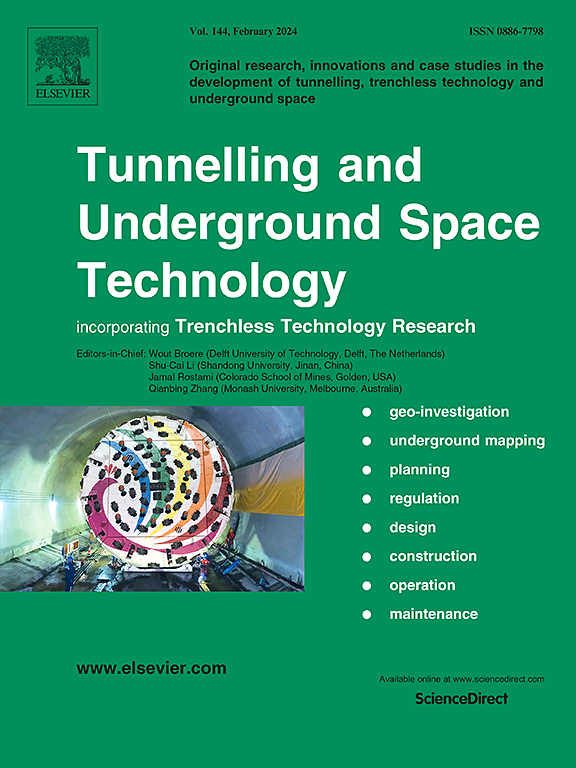数据与经验驱动的双盾构隧道复杂沉降曲线预测方法及其演化
IF 7.4
1区 工程技术
Q1 CONSTRUCTION & BUILDING TECHNOLOGY
引用次数: 0
摘要
机器学习算法在岩土工程中的应用越来越普遍。完全由数据驱动的机器学习算法存在“黑箱”问题,缺乏发现因果关系的能力,无法在变量选择中表现出偏好。因此,数据和经验驱动的机器学习算法逐渐出现。针对复杂地表沉降曲线及其演化的预测问题,提出了一种数据和经验驱动的机器学习预测方法。用“预测公式-沉降曲线”的方法代替了传统的“沉降点-沉降曲线预测”的方法。该方法首先根据地面沉降曲线的特点选择合适的公式,保证公式参数具有物理意义。然后,利用机器学习对公式内的参数进行预测,进而推导出地面沉降曲线。这些参数的敏感性分析探讨了因果关系,并确定了模型偏好。最后,将该方法应用于双盾构隧道开挖引起的地面沉降曲线的预测,采用叠加的Peck曲线作为预测公式。利用GRNN和LSTM算法对地面沉降曲线内的未定参数进行预测,在保证最大沉降等关键指标预测精度的同时,有效地捕捉了沉降曲线的整体形态,取得了令人满意的结果。该方法增强了机器学习预测地面沉降的可解释性,为预测复杂地面沉降曲线的整体形式提供了有价值的见解。本文章由计算机程序翻译,如有差异,请以英文原文为准。
Data-and experience-driven prediction method of twin shield tunneling-induced complicated settlement curve and its evolution
The application of machine learning algorithms in geotechnical engineering is increasingly prevalent. Solely data-driven machine learning algorithms suffer from the “black box” issue, lacking the ability to uncover causal relationships and exhibiting preferences in variable selection. Consequently, data-and experience-driven machine learning algorithms are gradually emerging. Addressing the prediction of complex ground settlement curves and their evolution, this paper proposes a novel data-and experience-driven machine learning prediction method. Specifically, it replaces the traditional “prediction of settlement points—settlement curve” approach with “prediction formula—settlement curve”. This method first selects an appropriate formula based on the characteristics of ground settlement curves, ensuring that formula parameters possess physical meanings. Subsequently, machine learning is employed to predict the parameters within the formula, which are then applied to derive the ground settlement curve. Sensitivity analysis of these parameters explores causal relationships and identifies model preferences. Finally, this approach is applied to predict ground settlement curves induced by twin shield tunnels excavation, using overlaid Peck curves as the prediction formula. GRNN and LSTM algorithms are employed to predict undetermined parameters within the ground settlement curve, yielding promising results that ensure accuracy in predicting key indices like maximum settlement while effectively capturing the overall shape of the settlement curve. This method enhances the explainability of machine learning in predicting ground settlement and provides valuable insights for forecasting the overall forms of complex ground settlement curves.
求助全文
通过发布文献求助,成功后即可免费获取论文全文。
去求助
来源期刊

Tunnelling and Underground Space Technology
工程技术-工程:土木
CiteScore
11.90
自引率
18.80%
发文量
454
审稿时长
10.8 months
期刊介绍:
Tunnelling and Underground Space Technology is an international journal which publishes authoritative articles encompassing the development of innovative uses of underground space and the results of high quality research into improved, more cost-effective techniques for the planning, geo-investigation, design, construction, operation and maintenance of underground and earth-sheltered structures. The journal provides an effective vehicle for the improved worldwide exchange of information on developments in underground technology - and the experience gained from its use - and is strongly committed to publishing papers on the interdisciplinary aspects of creating, planning, and regulating underground space.
 求助内容:
求助内容: 应助结果提醒方式:
应助结果提醒方式:


